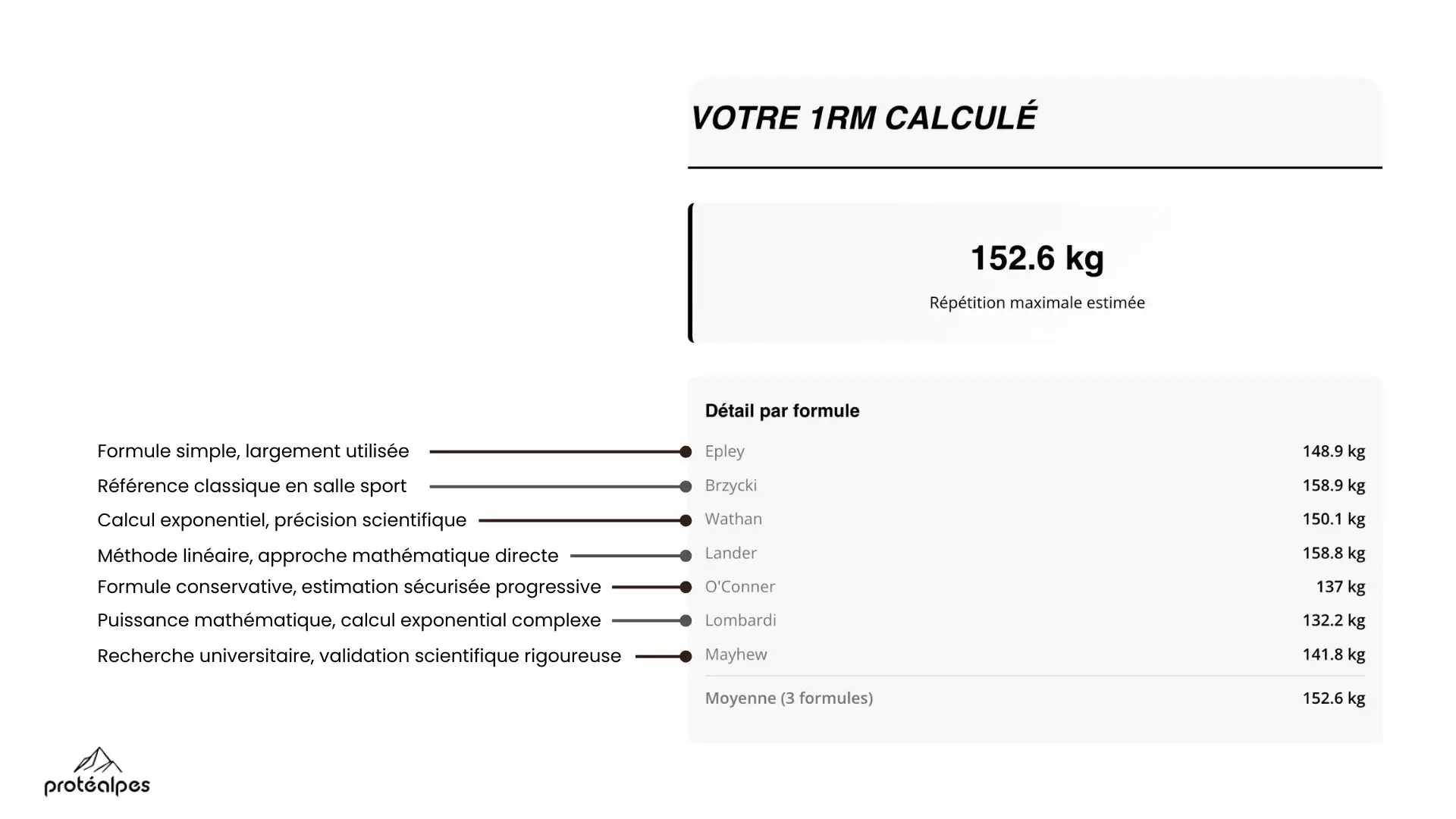Calculate your maximum repetition (1RM) from your performance.
Your calculated 1RM
Estimated maximum repetition
Details by formula
Percentage table
| Percentage | Weight (kg) | Training zone |
|---|
- 90-100%: Maximum strength test
- 85-95%: Strength training (1-5 reps)
- 70-85%: Hypertrophy and strength (6-12 reps)
- 50-70%: Muscular endurance (12+ reps)
What is 1RM?
Maximum repetition (1RM) represents the maximum load an athlete can lift once on a given exercise with perfect technical form.
This concept of maximum strength is the ultimate reference for assessing a person's strength capacity and determining the optimum load for each training session.
Direct testing of 1RM presents a high risk of injury, particularly for novice exercisers. That's why estimation formulas allow this maximum repetition to be calculated from a lighter load lifted over several repetitions.
How to use the calculator
The Protéalpes calculator requires three essential pieces of information:
- the type of exercise (polyarticular such as squat or bench press, versus isolation),
- the weight lifted,
- the number of repetitions performed.
To optimize accuracy, perform your physical test with a load allowing between 3 and 12 repetitions, performed over 3 to 5 sets. Warm up thoroughly, work with a safety partner, and use a load representing 80-90% of your estimated maximum. Note that adequate rest between sets is important to maintain the quality of your repetitions during the test.
The application automatically calculates your overall score using several calculation methods, then displays a table of corresponding training percentages.
These figures enable you to determine precisely your workload for each objective: hypertrophy (70-85%), strength gain (85-95%), or maximum strength (95-100%), and to get an idea of your potential 1RM so that you can test it in real-life conditions.

Technical principles and methodological choices
Our calculator incorporates eight scientifically validated formulas.
Brzycki's formula: 1RM = Weight × (36 / (37 - Number)) remains the most widely used in the weight room.
Epley's formula: 1RM = Weight × (1 + Number/30) is a more conservative approach. Lombardi's formula uses a different exponential method.
The system defaults to an average of the three most reliable formulas (Brzycki, Epley, Wathan) to obtain a more robust result. This approach limits the effect of individual variations and provides a more accurate estimate than using a single formula.
Indeed, the comparison reveals significant differences between the different calculation methods, particularly beyond 10 repetitions.
While Brzycki and Wathan tend towards conservative estimates, Lombardi and O'Conner produce more optimistic results, with discrepancies of up to 15-20 kg on a single test.
This analysis enables practitioners to understand why two different formulas give different figures for the same performance.
The tool also helps to determine which formula to favor according to your objective and level. An experienced athlete can analyze convergences over his usual range of repetitions, while a beginner will benefit from more conservative formulas to avoid overestimation.
This approach transforms the 1RM calculation from a simple mathematical extrapolation into a customized analysis tool.
Formulas used
- Epley: 1RM = Weight × (1 + Repetitions/30)
- Brzycki: 1RM = Weight × (36 / (37 - Repetitions))
- Wathan: 1RM = (100 × Weight) / (48.8 + (53.8 × e^(-0.075 × Repetitions)))
- Lander: 1RM = (100 × Weight) / (101.3 - 2.67123 × Repetitions)
- O'Conner: 1RM = Weight × (1 + 0.025 × Repetitions)
- Lombardi: 1RM = Weight × Repetitions^0.1
- Mayhew: 1RM = (100 × Weight) / (52.2 + (41.9 × e^(-0.055 × Repetitions))
Limitations and practical considerations
Mathematical extrapolation has intrinsic limitations. Beyond 15 repetitions, all formulas become less reliable, as work shifts towards endurance rather than strength. In the case of isolation exercises, precision decreases in comparison with polyarticular movements.
The muscle mass involved directly influences the validity of the calculation. A bench press calls on several muscle groups, enabling better extrapolation performance, unlike a biceps curl, which rapidly fatigues the targeted muscle.
Training level is a determining factor. A beginner often presents overestimated results, while an experienced athlete may find more accurate estimates thanks to his technical mastery and ability to carry heavy loads safely.
Concrete applications
This reference tool enables you to make methodical progress.
For example, if your 1RM in the squat is 120 kg, working at 85% (total weight of 102 kg) over 3-5 repetitions will optimize strength gain.
At 70% (84 kg), you can work on hypertrophy sets of 8-12 repetitions for weight gain, for example.
It's important to remember that, although we talk of hypertrophy between 70 and 80% of 1RM, hypertrophy is actually a phenomenon of muscle adaptation to stimuli linked to workloads at different intensities. We build muscle by varying intensities, from 50 to 100% of 1RM, not just from 70 to 80%.
The generated table helps you plan several weeks of training, varying intensities. This method avoids stagnation and means structured progress towards your goals. The duration of your program will depend on your specific objectives and starting level.
Understanding your 1RM also helps you optimize your recovery. After heavy sessions (>85% 1RM), a longer recovery time is required. Post-training nutrition also plays a major role in optimizing your performance.
For exercisers in the muscle development phase, the use of a gainer may be relevant to support strength gains. Creatine is also a scientifically proven supplement for improving performance in short, intense efforts (>70% of 1RM).
Safety and recommendations
Trying out a real 1RM remains risky without preparation. Our tool eliminates this risk while providing the necessary information for your bodybuilding program. Take 1-3 minutes recovery time between test attempts, and always perform several sets of progressive warm-up.
Taking advantage of this data requires a progressive approach. Gradually increase your weekly series load, regularly evaluate your performance, and adjust your percentages according to your feelings and results.
This calculator is a scientific way of estimating your potential while preserving your safety. Use these figures as a basis for your work, not as an attempt at an absolute record.
You can also complete your preparation by generating your own customized load table.
Further information
Drying phase:
The best exercises for dry training
How to avoid muscle loss during dry training
Optimizing training:
Optimum rest time between sets
Complete recovery guide














